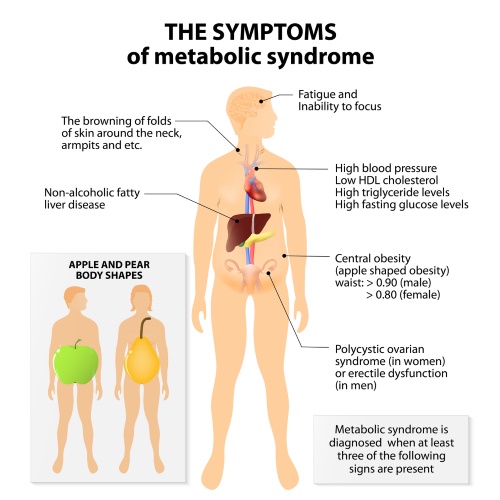DrCarney.com Blog
What is Metabolic Syndrome?
Metabolic syndrome is a term often mentioned these days when public health is discussed. We hear about it on the news and see it mentioned in blogs and articles. But have you ever wondered, "Exactly what is metabolic syndrome?" You're not alone.
By definition, a syndrome is a rather slippery thing. It doesn't exactly fit easily into our doctor's box of diagnoses. In very broad terms, we can say that the majority of medical conditions have symptoms indicating a diagnosis which is confirmable with a test or exam. Itchy, watery eyes and nasal congestion that occurs only in the spring are symptoms of an allergy. If necessary, a physician can confirm this diagnosis by ordering an allergy test. Broken bones exhibit with pain and swelling, usually following trauma. An x-ray confirms the diagnosis. But a syndrome is less straightforward.
What is a Syndrome?
A syndrome is a cluster of symptoms that when taken together comprise the condition. For example, bloating, mood swings, acne flare ups, insomnia, breast tenderness, headaches, depression, joint pain, and fatigue in the days leading up to a woman's period can all be symptoms of premenstrual syndrome (PMS). Some women may only experience a couple of these symptoms, others might have four or five. Each person's particular cluster of symptoms is unique. But we recognize that this group of symptoms is all related to the same condition.
Metabolic syndrome (MetS) is likewise a cluster of associated symptoms. Physicians have to look at a person wholistically before making a diagnosis of MetS. Some of the clues are visible, like obesity centered around the waist, skin tags, or browning of the skin in the folds around the neck. Another clue might be an obese young woman who presents with a complaint of irregular periods and is diagnosed with high blood pressure. Physicians use blood tests to help establish the diagnosis.
The Symptoms of MetS
Because a syndrome can have many characteristics associated with it, physicians had to agree on what symptoms are required for a MetS diagnosis. Also known as Syndrome X, insulin resistance syndrome, and dysmetabolic syndrome, patients diagnosed with MetS must exhibit three of the following risk factors:
• Elevated fasting blood triglycerides: 150 mg/dL or higher or taking medication for high triglycerides.
• Low HDL cholesterol level: below 40 mg/dL for men or under 50 mg/dL for women. Or on medication for low HDL cholesterol.
• Raised fasting glucose (blood sugar): 100 mg/dL or more or taking medicine for high blood glucose.
• Elevated blood pressure: 130/85 mm Hg or higher or taking medicine for high blood pressure.
• Central obesity: waist circumference of more than 40 inches for men or greater than 35 inches for women.

The Significance of a MetS Diagnosis
Rather than using the word "symptoms" to describe the constellation of factors which comprise a MetS diagnosis, physicians usually refer to them as a cluster of "risk factors." The problem with a MetS diagnosis is that it means a patient is at a much higher risk for some major health problems.
The American Heart Association describes the risk factors:
1. Cardiovascular disease. The arteries become hardened and narrow with plaque build up. Although this happens throughout the body, causing pain and leading to degenerative conditions, cardiovascular disease in the arteries leading to the brain, heart, kidneys, and legs is especially dangerous.
2. Coronary heart disease and heart attack. Narrowed arteries supplying the heart allow less blood and oxygen to reach that vital organ, resulting in chest pain (angina) or heart attack.
3. Stroke. When the blood supply to part of the brain is cut off by a blocked or burst artery, brain cells begin to die. Brain damage, other complications, or death are all possible outcomes.
4. Type 2 diabetes. When the body is either no longer able to use insulin properly or loses the ability to make insulin, diabetes occurs. Without insulin, sugars build up in the blood, increasing the risk for kidney failure and cardiovascular disease.
Warning Signs Can Prevent Disease
Currently, 34 percent of Americans have a been diagnosed with MetS. As obesity continues to rise, more diagnosis are expected. In and of itself, MetS is not a disease. It is simply an enormous warning sign that there's trouble ahead. But just like the highway department posts warning signs in time for drivers to avoid danger, a diagnosis of MetS can alert us in time for us to change course and avoid disease.
Adopting a diet based on whole plant foods with no added oils will help us stop and even reverse the risk factors of MetS. We don't have to develop diabetes or experience the scary consequences of cardiovascular disease. My Starch-Smart® System is designed to help put you on the road to optimal health. I invite you to learn more by joining the online community at DrCarney.com where others can help you on the road to optimal health.
Scroll Down Page to Leave Comments

Want to Make Lifestyle Changes?
Not sure how to start? The good news is that Help is Only a Click Away! We invite you to join Dr. Carney's Helpful Sharing Community.
Preview the "Diabetes in Retreat" Trailer
No More Meds?: Got a family history? Outsmart it! Decrease your need for medication naturally with Dr. Carney. Her patients can REVERSE Diabetes Type II. Which foods worsen insulin resistance? Find out now. Get the keys to lowering your insulin resistance with her proven methods for success. Finally, an MD who helps even Type 1 diabetics reduce insulin requirements using her Starch-Smart® System, a science-based plan to help you normalize weight and blood sugars.
When you subscribe to the blog, we will send you an e-mail when there are new updates on the site so you wouldn't miss them.




